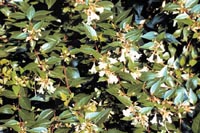Resource Library
Plant of the Week: Glossy Abelia
The University of Arkansas System Division of Agriculture does not promote, support or recommend plants featured in "Plant of the Week." Please consult your local Extension office for plants suitable for your region.
Plant of the Week
Glossy Abelia
Latin: Abelia x grandiflora

I once worked in a nursery and had a customer request a shrub for their landscape
that was evergreen and bloomed all summer long. That’s a tall order but a shrub that
comes awfully close is the old fashioned glossy abelia. While it’s semi-evergreen
at best it does produce half inch long white blooms from mid May until the first hard
freeze, a feat shared by few garden shrubs. While the glossy abelia is never covered
with a mass of flowers like an azalea, its persistence of bloom keeps it from receding
into the background with the other spring blooming shrubs.
It is appropriate that glossy abelia should be such a determined bloomer because
it is a reminder of the stiff-upper-lip attitude of those who initially found, lost
and then finally introduced it into cultivation. Abelia is named after Clarke Abel
(1780-1826) who was a surgeon and naturalist on the second unsuccessful British embassy
to China in 1816. The embassy was attempting to obtain more favorable trading privileges
for the English East India Company, which they finally accomplished by the Opium Wars
20 years later.
Abel collected specimens and seeds of a new plant, later named Abelia chinensis in
his honor, while he and the embassy were being politely but firmly ushered out of
the country along the Grand Canal. On his return voyage the ship struck an uncharted
reef and the party found itself shipwrecked near present day Sumatra in Indonesia.
The day after the wreck they managed to retrieve some of the plant specimens only
to have the small boat they were using attacked and burned by pirates. While Abel
returned to England empty handed, he was fortunate enough to have left duplicate specimens
of some of the material with an acquaintance in Canton. These duplicate sets were
returned to him and used to establish the plant as a new member of the honeysuckle
family.
Abel’s Abelia was finally introduced into England as a living plant in 1844 by Robert
Fortune. Some time about 1900 a gardener or nurseryman had the inspiration to cross
Abelia chinensis with A. uniflora, another Chinese species, and the glossy abelia
as we know it today was born. Unfortunately no record remains of who made this cross.
Glossy abelia is an easily grown plant that should be located in bright light, or
preferably full sun. It produces long wispy growth covered with maroon tinged leaves
and terminal clusters of white bell shaped flowers that have a red calyx beneath the
flower. Too often the plant is sheared to make a clipped shrub that looks more like
a toadstool than a plant. A better remedy is to remember that the plant grows 6 feet
tall and wide, so give it plenty of room. When it needs pruning to control size, cut
it back severely in the spring just before it begins growing. It should be pruned
about as severely as the forsythia and at about the same time, which is early spring.
By: Gerald Klingaman, retired
Extension Horticulturist - Ornamentals
Extension News - August 13, 1999
The University of Arkansas System Division of Agriculture does not maintain lists of retail outlets where these plants can be purchased. Please check your local nursery or other retail outlets to ask about the availability of these plants for your growing area.